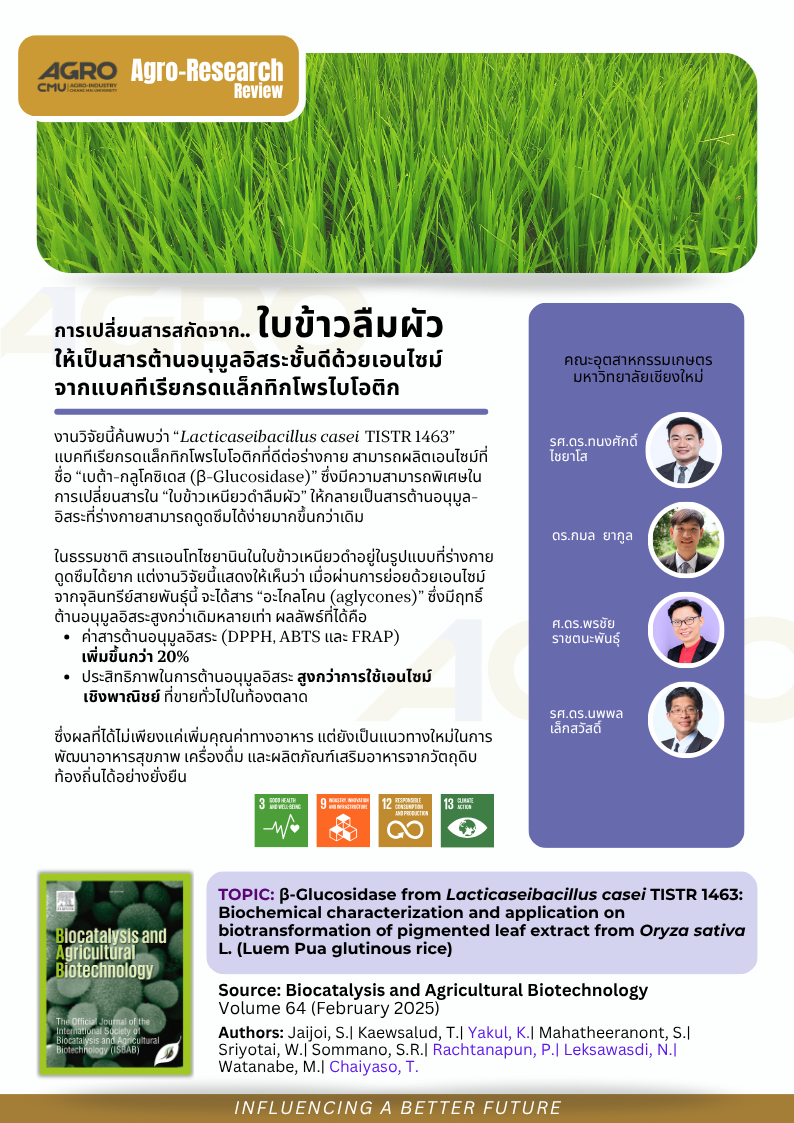
การเปลี่ยนสารสกัดจากใบข้าวลืมผัวให้เป็นสารต้านอนุมูลอิสระชั้นดีด้วยเอนไซม์จากแบคทีเรียกรดแล็กทิกโพรไบโอติก
งานวิจัยนี้ค้นพบว่า “Lacticaseibacillus casei TISTR 1463” แบคทีเรียกรดแล็กทิกโพรไบโอติกที่ดีต่อร่างกาย สามารถผลิตเอนไซม์ที่ชื่อ “เบต้า-กลูโคซิเดส (β-Glucosidase)” ซึ่งมีความสามารถพิเศษในการเปลี่ยนสารใน “ใบข้าวเหนียวดำลืมผัว” ให้กลายเป็นสารต้านอนุมูลอิสระที่ร่างกายสามารถดูดซึมได้ง่ายมากขึ้นกว่าเดิม
ในธรรมชาติ สารแอนโทไซยานินในใบข้าวเหนียวดำอยู่ในรูปแบบที่ร่างกายดูดซึมได้ยาก แต่งานวิจัยนี้แสดงให้เห็นว่า เมื่อผ่านการย่อยด้วยเอนไซม์จากจุลินทรีย์สายพันธุ์นี้ จะได้สาร “อะไกลโคน (aglycones)” ซึ่งมีฤทธิ์ต้านอนุมูลอิสระสูงกว่าเดิมหลายเท่า ผลลัพธ์ที่ได้คือ
- ค่าสารต้านอนุมูลอิสระ (DPPH, ABTS และ FRAP) เพิ่มขึ้นกว่า 20%
- ประสิทธิภาพในการต้านอนุมูลอิสระ สูงกว่าการใช้เอนไซม์เชิงพาณิชย์ ที่ขายทั่วไปในท้องตลาด
ซึ่งผลที่ได้ไม่เพียงแค่เพิ่มคุณค่าทางอาหาร แต่ยังเป็นแนวทางใหม่ในการพัฒนาอาหารสุขภาพ เครื่องดื่ม และผลิตภัณฑ์เสริมอาหารจากวัตถุดิบท้องถิ่นได้อย่างยั่งยืน
-
This research discovered that Lacticaseibacillus casei TISTR 1463, a beneficial probiotic lactic acid bacteria, can produce an enzyme called β-glucosidase that has a unique ability: it transforms compounds found in Luem Pua pigmented rice leaves into antioxidants that the human body can absorb more efficiently.
Naturally, the anthocyanins in pigmented rice leaves exist in a form (glycosides) that is difficult for the body to absorb. However, when treated with this enzyme, they are converted into aglycones, a form with significantly higher antioxidant activity. The results speak for themselves:
- Antioxidant levels (by DPPH, ABTS, and FRAP assays) increased by over 20%
- The antioxidant performance outperformed commercial enzymes currently available on the market
This innovation not only enhances nutritional value but also paves the way for creating functional foods, health beverages, and dietary supplements using sustainable, plant-based local resources.
Topic: β-Glucosidase from Lacticaseibacillus casei TISTR 1463: Biochemical characterization and application on biotransformation of pigmented leaf extract from Oryza sativa L. (Luem Pua glutinous rice)
Authors: Jaijoi, S.| Kaewsalud, T.| Yakul, K.| Mahatheeranont, S.| Sriyotai, W.| Sommano, S.R.| Rachtanapun, P.| Leksawasdi, N.| Watanabe, M.| Chaiyaso, T.
Abstract:
This study aimed to biochemically characterize a purified β-glucosidase from a probiotic Lacticaseibacillus casei TISTR 1463 and to apply the enzyme for improving antioxidant activities of Luem Pua (Oryza sativa L.) pigmented rice leaf extract (PRLE-LP). The effect of PRLE-LP supplementation in de Man, Rogosa, and Sharpe (MRS) medium, inoculum size, initial pH, and temperature were investigated using one-factor-at-a-time (OFAT) approach. Under optimal conditions, the maximal β-glucosidase activity of 38.43 ± 0.01 U/g DCW was achieved by cultivation strain TISTR 1463 in MRS-PRLE-LP medium (20:80% (v/v)), 10% (v/v) inoculum size, initial pH 3.5 at 30 °C for 36 h. Afterward, β-glucosidase was purified to 7.5-fold with 37% recovery yield and a molecular weight (MW) of 75 kDa. This purified enzyme had an optimal pH and temperature of pH 4.5 and 35 °C. It was stable under pH of 3.0–5.0 and temperature of 30–35 °C and showed the highest specific activity toward 4-nitrophenyl β-D-glucopyranoside (p-NPG) with the Km and Vmax of 1.31 mg/mL and of 0.06 μmol/min/mg. The enhancement of antioxidant activities of PRLE-LP by purified β-glucosidase from strain TISTR 1463 and commercial enzyme was also studied. An in-house β-glucosidase displayed superior antioxidant activities over the commercial enzyme from Aspergillus niger. In addition, LC-QTOF-MS analysis confirmed that β-glucosidase efficiently converted glycone into aglycone, resulting in enhanced antioxidant activities. The potential for producing antioxidant-rich substances from anthocyanin-containing alternative crops with applications in food and pharmaceutical industries that are both health and eco-friendly is thus addressed.
Keywords: Antioxidant activity; β-Glucosidase; Lacticaseibacillus casei; TISTR 1463;
View at publisher: https://www.sciencedirect.com/science/article/pii/S1878818125000040?via%3Dihub
#อกมช. #agrocmu #CMU






